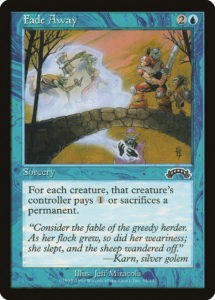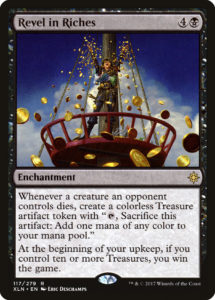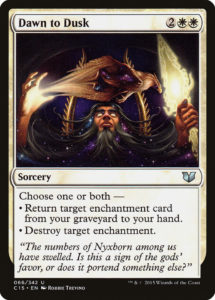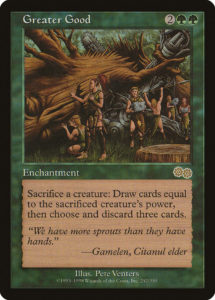Magic has entered an era of change and uncertainty.
Questions abound about how different the game will be if/when Best of One supplants Best of Three. MTG Arena is both pushing this change to the game as well as popularizing it. Next month, the Mythic Invitational will introduce Duo Standard, one where players build a second deck instead of a first sideboard (which both requires players to own more cards and not learn the intricate task of sideboarding). The invited players include not only some of Magic’s most talented professionals but also many of its best streamers.
Paper Magic support seems to be dwindling. The community has waited months for Wizards to announce what (if anything) will replace PPTQs, what in-store Mythic Championship Qualifiers will look like, how Pros can chase the MPL, and when the next set is coming out. Communication from WotC has been sparse and odds are they haven’t yet all these particulars. People on Reddit, on Twitter, and even in my local game store are worried, seeing this as a dangerous time for the game they love so much.
I understand that all of these can be frustrating and frightening. Change and uncertainty are hard to tolerate. Not knowing can be agonizing. However, these are good problems for Magic to have. The game is not dying—these are growth spasms of a game doing very well, not its death knells. If we go back a single year, however, Magic was in a very different state.
The Real Problems of Yesterday
Today is Tuesday, February 5th, 2018, one year ago today.
Rivals of Ixalan has just released. It’s doing good work fixing Ixalan’s pretty abysmal Limited format, although the Sealed format is heavily defined by uninteractive mega-bombs like Profane Procession. Attune with Aether, Rogue Refiner, Rampaging Ferocidon, and Ramunap Ruins were banned three weeks ago, bringing the Standard banlist up to nine. This is the fourth round of Standard bannings in one year, an unprecedented disaster.
Tournament attendance has been dwindling for the past two years, especially for Standard. The Standard Showdown seems a clear symptom of this downturn, and the prognosis for Magic’s flagship format is bleak. Evidence increasingly points to Modern being more popular, a terrible thing for a game which lives and dies on people purchasing current releases rather than singles via the secondary market. With Limited and Standard participation depressed, Magic is almost certainly making less money.
Limited as a whole has seen better days. Ixalan was one of the worst formats in a long time (and the two block paradigm definitely had its share of clunkers and triumphs). Iconic Masters had huge issues, and unbeknownst to us, next month Masters 25 will similarly disappoint and sink the Masters line. The two block paradigm and its experiment in six month rotations has made for an erratic era, to be kind. MTG Arena is in closed beta, isn’t too pretty or functional, and lacks a clear target demographic despite Magic’s large investment. Magic is in a precarious place, and it’s continuing to dramatically experiment by eliminating small sets, reinstate Core Sets, and add an entire new team to R&D.
In short, things haven’t been going great for Magic, and they’ve not been great since—Khans? That was three years ago. The game isn’t dying, but it’s believable that Magic has already peaked and entered a long, slow period of decline.
Wild Successes, Different Problems
Today, February 5th, 2019, things are quite different. MTG Arena is wildly successful. Play Design’s contributions—which only really took effect when GRN rotation pushed Kaladesh out of the format—have made one of the best Standard environments in recent memory and dramatically changed every other Constructed format. Dominaria and Ultimate Masters proved that Wizards can still make excellent Limited environments. Magic is beating Hearthstone on Twitch. MTG Arena has possibly brought one of the biggest expansions in the history of the game. WotC has just dedicated ten million dollars to competitive play, a completely unprecedented number in the TCG world. Magic isn’t dying, it’s thriving.
Now, just because things are going well doesn’t mean one isn’t entitled to be frustrated. It was disheartening playing at Grand Prix New Jersey, hearing feature matches be called, and learning that they were completely meaningless. There was no coverage, nor an announcement of what the future will look like. There seems to be little reason for Spikes to build a physical Standard deck—with no PPTQs, the highest level of local paper competition you’ll find is a Standard Showdown unless you live right on the SCG Tour or near a Standard MagicFest. There’s a fear that many Pros might leave Magic altogether. The top of the Pro pyramid might be better than ever, but it may be both thinner and more rarefied than before.
The Necessity of Change
In all things, to not change with the times is to stagnate, and eventually to die. This is why game sequels always add (and often remove content), why writers write stories about different people, and why painters can’t get by on just repainting the exact same thing, time and again. Magic has successfully threaded the needle between innovation and consistency for twenty-five years. Magic cards don’t look the way they did in ’93, aren’t templated as they once were, and have gained hundreds of new keywords, creature types, and lore terms; but it’s still recognizably the same game. It has heavily mined design space while generating entirely new veins to explore. Once upon a time, there was no Pro Tour, no Planeswalker card type, no plane of Ravnica, nor even a Magic. All of them were bold experiments that ended up paying massive dividends. Sure, many experiments weren’t successful, but you’re allowed to have some Coldsnaps, Megamorphs, and Dominaria leaks alongside Khans of Tarkir, Flashback, and Unstable spoilers.
Right now might seem like a very scary time. It might seem like Magic is on the verge of transforming into something demonstrably different, that’s it’s trying to become much more like Hearthstone, that it values streamers over Pros, and that paper Magic might have begun its slow journey into retirement. Well, I can’t promise that none of these will come to pass, but I can say that if they do transpire, that might not be bad.
It’s about All of Us
Last February, Gavin Verhey announced the end of Modern Masters and that Masters sets would be themed products with broader appeal. The focus shifting to include Commander and casual players meant that Masters sets were no longer targeted as heavily at me and players like me. This was disappointing, but led to the important recognition that not everything should be targeted towards me. Heck, as an enfranchised player, I (and I’d wager, a majority of people reading this) are catered to more than any other demographic. We get four massive releases every year. The entire Play Design team exists to ensure that we have a great time no matter how we use these products. Every other thing Magic does is tiny by comparison to its expansions, so Magic broadening its scope to include more people with an additional product is small potatoes by comparison.
MTG Arena has dramatically increased Magic’s audience and accordingly, the size of the people within its focus. However, none of this is coming at the expense of the products we’ve come to expect, it’s merely adding several more ways to play Magic. This is a huge boon to both Magic and its player base—if this increased the size of Magic’s invisible player base (as of a few years ago, 94% of Magic players never had a DCI number or participation in any kind of in-store play) by just one percent, well, that means Magic probably just added more players than have been active in any kind of tournament play for the past year.
The Mythic Invitational suggests that streamers might be more important to WotC than Pros. That could become the case, but setting aside $2.4 million to pay 32 of the world’s best to play your game for one year makes that unlikely. If Magic were focusing less on tournament play, Wizards would focus on digitally patching problematic cards rather than add an entire team to R&D. And if streamers do supplant pros, well, that means that streamers will have proved better ambassadors for the game than Pros (who are selected first and foremost for their skill at the game and less for their ability to entertain). Would you really love Reid Duke less if he was known best as a Pro Streamer than as a Pro Player?
MTG Arena having separate formats and a separate banlist suggests that paper is going to play second fiddle and perhaps eventually fade away. That could happen, but we still have Grand Prix, in-store play, and hundreds of millions of Magic card produced annually. Arena is still young and experimental; who knows what just this year will bring? And if paper play does fade out and Arena is the only place to play tournament Magic? Well, then tournament Magic became cheaper and those of us who prefer analog Magic will have to settle for playing paper Magic just to have fun. Fun: the thing that probably got most, if not all of us, into this wonderful game in the first place.
The sky is not falling. The world is changing, but to change is to stave off stagnation. All isn’t ideal—some of these changes are going to be Coldsnaps and some of them Innistrads, and Magic really could improve on its communication, but these are exciting times, not the end-times. Here’s looking forward to seeing what the next months bring.
And, as always, thanks for reading.
—Zachary Barash is a New York City-based game designer and the commissioner of Team Draft League. He designs for Kingdom Death: Monster, has a Game Design MFA from the NYU Game Center, and does freelance game design. When the stars align, he streams Magic.
His favorite card of the month is Coat With Venom. It does a whole lot for a single mana and heralded the design of many more flexible combat tricks. Plus, it’s a solid combat trick that neither cantrips nor provides a massive power buff, which is hard to do.





